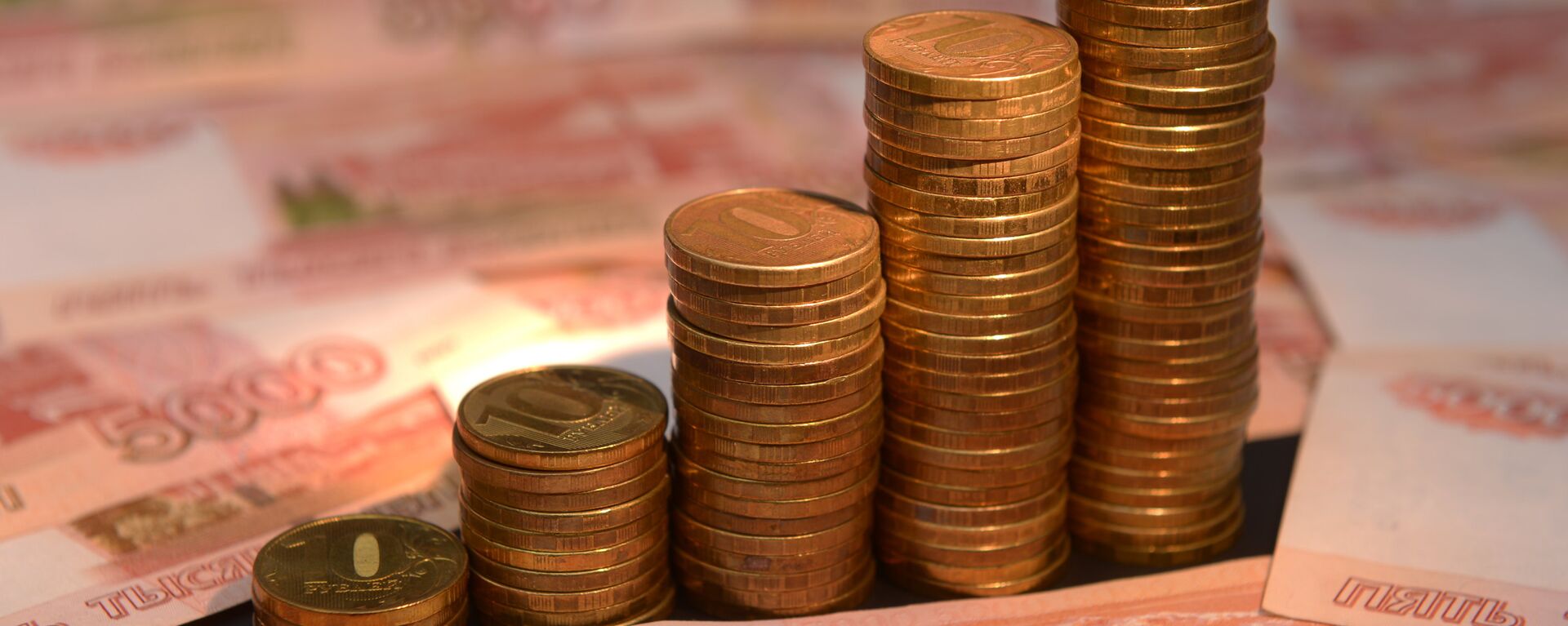https://sputnikglobe.com/20230803/can-i-invest-in-the-digital-yuan-1112369792.html
Can I Invest in the Digital Yuan?
Can I Invest in the Digital Yuan?
Sputnik International
The rise of China's digital yuan, or e-CNY, poses a significant challenge to the dominance of the US dollar in global trade settlements, signaling a potential shift in the world's financial landscape.
2023-08-03T18:53+0000
2023-08-03T18:53+0000
2023-09-01T12:48+0000
economy
industrial and commercial bank of china (icbc)
people's bank of china (pboc)
sputnik
east
pacific
china
mao zedong
opinion
newsfeed
https://cdn1.img.sputnikglobe.com/img/07e5/04/08/1082573756_0:245:3072:1973_1920x0_80_0_0_d3649313b364f66d49e191130f3920de.jpg
Over the next 10 years, the Chinese digital yuan (also known as digital renminbi, e-renminbi, Digital Currency Electronic Payment, or eCNY) is expected to shake up the status of the US dollar as the leading currency for global trade settlements, expresses Richard Turrin, author of Cashless: China's Digital Currency Revolution.Sputnik explains all you need to know about the electronic Chinese yuan: what it is and how it works.Central bank digital currencies (CBDCs), as described by the United States Federal Reserve, are models of a nation's legal tender in electronic or digital form. CBDCs can be categorized as either wholesale, devoted to inter-bank transactions, or retail, meant for individuals and businesses.What is the e-Yuan? The e-CNY is a contemporary form of money in China. It is equal to coins and paper money, but its use is all online and managed by the Central Bank, the People’s Bank of China (PBOC). China's e-currency constitutes its total monetary supply or monetary base (M0), representing 0.13 percent of renminbi cash and reserves in the Central Bank's holdings."Starting from December 2022, e-CNY in circulation has been included in the amount of currency in circulation," according to China's apex bank report. As the second half of 2022 wraps up, the digital Yuan amounted to $2 billion.Why the Digital Chinese Yuan was IntroducedThe Chinese Central Bank resolved to introduce the e-renminbi based on four convictions:What Does the e-Yuan Look Like?As a Chinese electronic legal tender, the digital yuan renminbi is easily recognizable on a smartphone and special digital cards, as it bears Mao Zedong's portrait like the paper bill. Even those who use ordinary mobile phones won't be excluded from using the digital yuan, since it doesn't need an Internet connection to carry out transactions.How does the Digital CNY work?According to sources, the Chinese digital yuan works in a four-layered triangular pattern: How to Open an e-Yuan WalletThe first step toward having the Chinese electronic CNY wallet is to download the digital yuan app now available on the iOS and Android platforms. People in 23 Chinese pilot cities can access it through their local app stores. By signing up with various commercial banks, millions of users can use the e-CNY using this app. After installing the e-renminbi app, sign up with a valid/active Chinese mobile number.Can a Foreigner Use the e-Yuan App?Non-Chinese nationals can access the digital currency using the e-yuan app, but certain conditions apply. First, they must be present in one of the designated pilot cities or regions. Additionally, they need to possess a bank account with one of the authorized Chinese banks.To sign-up for the Chinese e-RMB, WeChat Pay and Alipay-affiliated online banks are available, but it appears it remains essential to link a Chinese bank account to top up the digital wallet.The digital yuan app provides limited functions for foreign users at this time, primarily due to the prerequisite of a Chinese identity card for accessing certain "higher-level" wallet features with increased spending limits. The current option available to foreigners is the basic-level wallet, with daily and yearly spending limits set at RMB 5,000 and RMB 50,000, respectively, and it does not require a Chinese identity card to sign up.Is the Digital Renminbi Yuan a Cryptocurrency?The digital yuan is not based on a decentralized model and does not utilize blockchain technology, so it is not a cryptocurrency.Can the e-Yuan Replace the US Dollar?China has been making significant strides in the implementation of its Central Bank digital currency and currently maintains a considerable lead over other countries in this field. The motivation behind exploring alternative payment systems stems from nations wanting to decrease their complete reliance on the dollar, which stands at "mostly 100%."By engaging with regulators across various jurisdictions, multinational financial institutions, and universities, the Chinese Central Bank, as outlined in its white paper, has been actively involved in formulating standards for digital currencies.The recent show of force in the Asia-Pacific and Middle East, combined with the imposition of extensive sanctions against other nations, has caused skepticism towards the US reputation and the stability of the greenback, exacerbated by the lack of coherent leadership during the ongoing NATO proxy war against Russia in Ukraine.
https://sputnikglobe.com/20230411/smart-swift-secure-what-is-russias-digital-ruble-1109337756.html
https://sputnikglobe.com/20230730/russia-rolls-out-digital-ruble-new-form-of-national-currency-takes-shape-1112262256.html
east
pacific
china
Sputnik International
feedback@sputniknews.com
+74956456601
MIA „Rossiya Segodnya“
2023
Chimauchem Nwosu
https://cdn1.img.sputnikglobe.com/img/07e7/09/01/1113046371_0:99:1536:1635_100x100_80_0_0_9c5c627283eca931c39fe4852bbb301c.jpg
Chimauchem Nwosu
https://cdn1.img.sputnikglobe.com/img/07e7/09/01/1113046371_0:99:1536:1635_100x100_80_0_0_9c5c627283eca931c39fe4852bbb301c.jpg
News
en_EN
Sputnik International
feedback@sputniknews.com
+74956456601
MIA „Rossiya Segodnya“
Sputnik International
feedback@sputniknews.com
+74956456601
MIA „Rossiya Segodnya“
Chimauchem Nwosu
https://cdn1.img.sputnikglobe.com/img/07e7/09/01/1113046371_0:99:1536:1635_100x100_80_0_0_9c5c627283eca931c39fe4852bbb301c.jpg
digital yuan, ecny, chinese digital currency, e-yuan, e-renminbi, china's central bank digital currency, cbdc, digital currency revolution, people's bank of china, financial inclusion, reducing currency costs, better control of money, competition with digital payment platforms, cross-border transactions, electronic legal tender, mao zedong portrait, digital yuan wallet, e-yuan app, foreigner access, chinese identity card, digital yuan as cryptocurrency, digital yuan vs. us dollar, us dollar's usage in international trade, china's digital currency white paper, asia pacific and middle east geopolitics, us reputation, nato proxy war, russia, ukraine.
digital yuan, ecny, chinese digital currency, e-yuan, e-renminbi, china's central bank digital currency, cbdc, digital currency revolution, people's bank of china, financial inclusion, reducing currency costs, better control of money, competition with digital payment platforms, cross-border transactions, electronic legal tender, mao zedong portrait, digital yuan wallet, e-yuan app, foreigner access, chinese identity card, digital yuan as cryptocurrency, digital yuan vs. us dollar, us dollar's usage in international trade, china's digital currency white paper, asia pacific and middle east geopolitics, us reputation, nato proxy war, russia, ukraine.
Can I Invest in the Digital Yuan?
18:53 GMT 03.08.2023 (Updated: 12:48 GMT 01.09.2023) The rise of China's digital yuan, or e-CNY, poses a significant challenge to the dominance of the US dollar in global trade settlements, signaling a potential shift in the world's financial landscape. With its growing adoption and potential advantages, the digital currency is poised to reshape the international finance sector in the coming years.
Over the next 10 years, the Chinese digital yuan (also known as digital renminbi, e-renminbi, Digital Currency Electronic Payment, or eCNY) is expected to shake up the status of the US dollar as the leading currency for global trade settlements, expresses Richard Turrin, author of Cashless: China's Digital Currency Revolution.
Sputnik explains all you need to know about the electronic Chinese yuan: what it is and how it works.
Central bank digital currencies (CBDCs), as described by the United States Federal Reserve, are models of a nation's legal tender in electronic or digital form. CBDCs can be categorized as either wholesale, devoted to inter-bank transactions, or retail, meant for individuals and businesses.
The e-CNY is a contemporary form of money in China. It is equal to coins and paper money, but its use is all online and managed by the Central Bank, the People’s Bank of China (PBOC). China's e-currency constitutes its total monetary supply or monetary base (M0), representing 0.13 percent of renminbi cash and reserves in the Central Bank's holdings.
"Starting from December 2022, e-CNY in circulation has been included in the amount of currency in circulation," according to China's apex bank report. As the second half of 2022 wraps up, the digital Yuan amounted to $2 billion.
Why the Digital Chinese Yuan was Introduced
The Chinese Central Bank resolved to introduce the e-renminbi based on four convictions:
Financial Inclusion: China wants to bring the unbanked population, especially in remote/rural communities, into the regular banking system to give these individuals access to financial services without hindrance and at a low cost.
Reducing Currency Costs: Printing and handling physical money is expensive. By using digital currency, China hopes to save money and make the process of handling money more efficient.
Better Control of Money: With digital RMB, the Chinese government can keep a closer eye on how money moves in the economy. This helps them implement their financial policies more effectively compared to using physical cash.
Competition with Digital Payment Platforms: China has seen the popularity of private digital payment services like Alipay and WeChat Pay. By introducing electronic cash, the government can offer an official digital currency alternative to keep control over the country's monetary system and also increase the safety and efficiency of retail payment services.
Expand Cross-Border Transactions What Does the e-Yuan Look Like?
As a Chinese electronic legal tender, the digital yuan renminbi is easily recognizable on a smartphone and special digital cards, as it bears Mao Zedong's portrait like the paper bill. Even those who use ordinary mobile phones won't be excluded from using the digital yuan, since it doesn't need an Internet connection to carry out transactions.
How does the Digital CNY work?
According to sources, the Chinese digital yuan works in a four-layered triangular pattern:
1.
At the peak is the
People's Bank of China - in charge of disbursing digital yuan and as such bears direct liability, while certain liabilities are borne by commercial banks.
2.
Second are operating institutions:
seven large state banks (Industrial and Commercial Bank of China, Agricultural Bank of China, Bank of China, China Construction Bank, Bank of Communications, Postal Savings Bank of China, and China Merchant's Bank) including
two online banks (WeBank i.e. WeChat Pay and MyBank i.e. AliPay) - in charge of handling the e-yuan wallet, disseminating the e-cash, and conducting know-your-customer (KYC) processes for customers.
3.
Third are
other banks and
payment service providers - providing services to digital CNY customers, but do not do exchanges.
4.
At the base of the pyramid are the
end-users (customers and businesses) - who either work with operating institutions, other banks, and service providers to establish payment infrastructure for eCNY receipts offline and online.
How to Open an e-Yuan Wallet
The first step toward having the Chinese electronic CNY wallet is to download the digital yuan app now available on the
iOS and
Android platforms. People in
23 Chinese pilot cities can access it through their local app stores. By signing up with various commercial banks, millions of users can use the e-CNY using this app. After installing the e-renminbi app, sign up with a valid/active Chinese mobile number.
Can a Foreigner Use the e-Yuan App?
Non-Chinese nationals can access the digital currency using the e-yuan app, but certain conditions apply. First, they must be present in one of the designated pilot cities or regions. Additionally, they need to possess a bank account with one of the authorized Chinese banks.
To sign-up for the Chinese e-RMB, WeChat Pay and Alipay-affiliated online banks are available, but it appears it remains essential to link a Chinese bank account to top up the digital wallet.
The digital yuan app provides limited functions for foreign users at this time, primarily due to the prerequisite of a Chinese identity card for accessing certain "higher-level" wallet features with increased spending limits. The current option available to foreigners is the basic-level wallet, with daily and yearly spending limits set at RMB 5,000 and RMB 50,000, respectively, and it does not require a Chinese identity card to sign up.
Is the Digital Renminbi Yuan a Cryptocurrency?
The digital yuan is not based on a decentralized model and does not utilize blockchain technology, so it is not a cryptocurrency.
Can the e-Yuan Replace the US Dollar?
China has been making significant strides in the implementation of its Central Bank digital currency and currently maintains a considerable lead over other countries in this field. The motivation behind exploring alternative payment systems stems from nations wanting to decrease their complete reliance on the dollar, which stands at "mostly 100%."
“If we go about five to 10 years out, yes the digital yuan can play a significant role in reducing the dollar’s usage in international trade,” Turrin noted.
By engaging with regulators across various jurisdictions, multinational financial institutions, and universities, the Chinese Central Bank, as outlined in its white paper, has been actively involved in formulating standards for digital currencies.
The recent show of force in the Asia-Pacific and Middle East, combined with the imposition of extensive sanctions against other nations, has caused skepticism towards the US reputation and the stability of the greenback, exacerbated by the lack of coherent leadership during the ongoing NATO proxy war against Russia in Ukraine.





